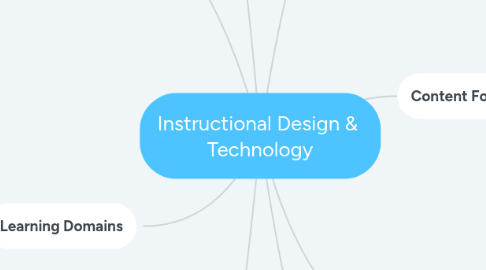Instructional Design & Technology
por R.C. Rice


1. Development & Design Basic Elements
1.1. Analysis
1.1.1. Needs Assessment
1.1.2. Business Needs
1.1.3. Performance Gap
1.1.4. Learning Needs
1.1.4.1. Learners' Background
1.1.4.2. Learners' Locus of Control
1.1.4.3. Learners' Motivation & Interests
1.1.4.4. Learners' Prior Knowledge & Skills
1.1.5. Task Analysis
1.2. Design & Development
1.3. Evaluation
1.3.1. Kirkpatricks Four Levels of Training Evaluation
1.3.2. Brinkerhoffs Success Case Method
1.3.3. Philips ROI Methodology
1.3.4. Chen's Theory-Driven Evaluation Model
1.3.5. Rossi's Five-Domain Evaluation Model
1.3.6. Stufflebeam's CIPP Evaluation Model
1.3.7. Patton's Utilization-Focused Evaluation
2. Instructional Frameworks/Models/Systems
2.1. ADDIE
2.2. Cathy Moores Action Mapping
2.3. Dick & Carey Model
2.4. Kemp Design Model
2.5. Merrills First Principles of Instruction
2.6. SAM (Successive Approximation Model)
2.7. Agile or rapid prototyping
3. Learning Domains
3.1. Taxonomy of Learning Domains
3.2. Cognitive domain
3.3. Psychomotor domain
3.4. Affective domain
3.5. Bloom's Taxonomy of Learning Domains
3.5.1. Creating
3.5.2. Evaluating
3.5.3. Analyzing
3.5.4. Applying
3.5.5. Understanding
3.5.6. Remembering
4. Related Roles
4.1. Instructional Designer
4.2. Subject Matter Experts
4.3. Researcher
4.4. Analyst
4.5. Content Developer
4.6. Graphic Designer
4.7. Evaluator
4.8. Facilitator, Instructor, or Training Specialist
4.9. Project Manager
4.10. Certified Performance Technician
4.11. Intervention Specialist
4.12. Change Manager
4.13. Editor (Text, Multimedia, etc.)
4.14. Scriptwriter
4.15. Content Systems Manager
4.16. Consultant
4.17. End-user or Intended Audience
4.17.1. Learner
4.17.2. Trainee
4.17.3. Trainer/Instructor

